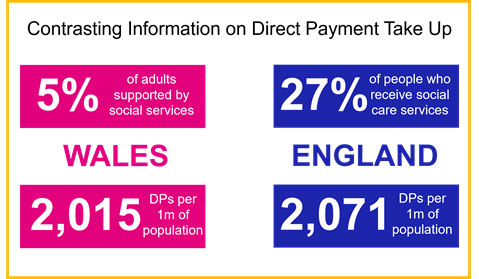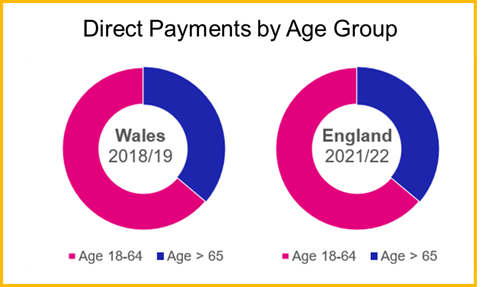- PPL: People Places Lives
- News
- Direct Payments in Wales
Direct Payments in Wales
We love our data analysis here at PPL. However, we've struggled to find much data on Direct Payments in Wales previously. We were therefore delighted to recently stumble across an Audit Wales report on Direct Payments for Adult Social Care that was published back in April 2022. We have several local authority clients in England, whereas we only have one in Wales (Powys County Council), so we were looking for the similarities and differences between Wales and England. Here is what we found when we dove in to it...
Data collection remains suspended in Wales
Welsh Government suspended the collection of social services performance measures (which included data on Direct Payments) in June 2020 due to Covid-19. Whilst data collection in relation to Direct Payments and Personal Health Budgets was also suspended in England at a similar time, it resumed some time ago, meaning that recent datasets are available. Data collection has not resumed in Wales and the most recent data on Direct Payments is for 2018/19.
Recommendation 10 in the report is that "Local Authorities and the Welsh Government annually publish performance information for all elements of Direct Payments to enable a whole system view of delivery and impact to support improvement". Over a year on from the report, this does not seem to have been implemented.
Many similarities in Wales and England
Many of the observations within the Audit Wales report are the same as might be said in England, such as:
- They work well - a subsequent Audit Wales report on service user's views said: "91% of those who we surveyed said that Direct Payments has had a positive impact on their independence and well-being".
- There is more to be done: "Our overall conclusion is that Direct Payments support people’s independence and are highly valued by service users and carers, but inconsistencies in the way they are promoted and managed by local authorities mean services are not always equitable and it is difficult to assess overall value for money."
- Struggles with recruitment: "Personal Assistants are essential to people making the most of Direct Payments, but service users struggle to recruit them".
- The importance of staff engagement: “…the likelihood of service users opting to use Direct Payments is mostly dependent on the tone, sincerity and genuineness of the offer and discussion with their social worker”.
- More publicly-available information is needed: "According to our survey, very few people
(2%) first found out about Direct Payments through published information".
Direct Payment take-up in Wales seems much lower than in England (but maybe isn't)
On of the headlines in the report is that 5% of the 125,415 adults supported by social services in Wales in 2018/19 received Direct Payments in Wales. The report comments: "The use of Direct Payments in Wales still lags behind England. Data published by NHS Digital Services shows that in 2020/21, 26.6% of people who receive social care services including 75.3% of carers in England receive Direct Payments".
Such a difference seems odd, and a potential explanation is that they are not comparing like-for-like. The % is calculated as: Number of Direct Payments (the numerator)divided by Total Number of Service Users (the denominator). If the definitions of both are not the same in Wales and England, then the comparison becomes less meaningful. Ways that this could happen are:
- Number of Direct Payments (numerator): The English stats quoted specifically reference over 75% of carers receiving a Direct Payment. It is not clear if the Wales stats included carers or not. If the English definition of what constitutes a 'Direct Payment' is wider than the Welsh definition, it will make uptake in Wales look comparatively low.
- Total Number of Service Users (denominator): The denominator for Wales is 125,000. Extrapolating the stats provided suggests that the denominator used for England is around 500,000 people, so a ratio of 1:4. However, the Office for National Statistics says that the population of Wales is 3.1m people and the population of England is 56.5m, a ratio of 1:18. If the Welsh definition of what constitutes a 'Social Care Service User' is wider than the English definition, it will again make uptake in Wales look comparatively low.
A safer comparison may be to look at Direct Payments as a proportion of total population. We estimate that there are 2,071 Direct Payments per 1m of population in England and 2,015 Direct Payments per 1m of population in Wales. This suggests that Wales perhaps does not 'lag behind' England and that council staff in Wales delivering Direct Payments can stop flagellating themselves!

Another indicator of Wales being on a similar footing to England is the split of Direct Payments by age. The split in Wales is almost exactly the same as our previous analysis of England found:

Rates in Wales are highly variable
The report also highlights that take-up levels vary a lot across the 22 local authorities in Wales. Whilst the average was 5%, rates range from 1.6% in Gwynedd to 12.9% in Ceredigion. By contrast, our previous analysis found that some local authorities in England have take-up rates approaching 40% and that there are just 11 English local authorities (out of 152) where direct payment uptake is less than 15%. Ignoring the cautionary comments above about the comparability of Wales and England stats, it is true that there is much more variability in take-up levels across Wales.
Interestingly, the Audit Wales report also highlights that the local rules on how Direct Payments can be used varies across local authorities, which may be ones of the reasons for the variation in uptake rates.
Anomaly with NHS Continuing Healthcare
Because Personal Health Budgets do not exist in Wales, the report identifies issues with some people who receive a Direct Payment from adult social care being reluctant to access NHS Continuing Healthcare as they fear they will lose their choice & control.
The opposite seems to be true in England where CHC funding is sometimes seen as being more generous and/or attractive due to lack of financial means testing.
This sees to be a thorny issue, and whilst some progress has been made, recommendation 8 in the report is that "Welsh Government ensure that people who receive both NHS continuing healthcare and Direct Payments have greater voice, choice and control in decision making".
Growth Opportunity?
This all depends on which statistics you subscribe to. Total spend on Direct Payments in Wales in 2021 was £79.5m, double the level it was in 2011. This was 3.5% of the total spend on social services, and is on the basis that roughly 5% of people get a Direct Payment. If an eventual target for Direct Payments in Wales is (say) 30% of people, this would result in Direct Payment spend across Wales increasing six-fold to about £475m per annum. That is a lot of Personal Assistants that are going to be needed!
Next steps
We are passionate about understanding, promoting and supporting Direct Payments and we continue to work closely with Powys County Council to expand their Direct payment offer. If you would like to talk about any of the things raised in this article or want to promote Direct Payments in your area, we'd love to hear from you.
